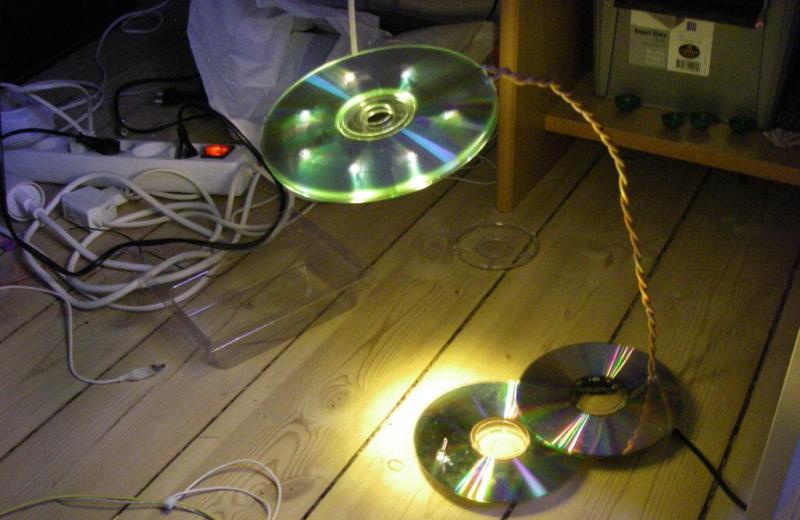[Artificial Intelligence] has made a desk lamp out of parts he had kicking around in his parts bin. Most recognizable are the 4 CDs that make up the base and the shade. To start this project, [Artificial Intelligence] sketched out a circular pattern on one of the CDs and marked 7 locations where the LEDs will be. Holes were drilled at those marked locations, the LEDs inserted and hot glued into place. Each LED has its own current limiting resistor soldered in a series configuration.
[Artificial Intelligence] mentions the resistor value was determined by a nice LED resistor calculator he found online, ledcalc.com. Then each LED/resistor combo was wired together in a parallel configuration and covered up by another CD to clean up the look and protect the wiring.
The base, like the top, is also made from 2 CDs, but this time there are 5 AA batteries underneath the CDs. These batteries don’t power the lamp, they are only used as a counterweight to prevent the lamp from tipping over. A USB cord runs to the lamp base, goes through an on/off switch and then up a pair of large-gauge solid core wire before connecting to the LED’s in the top of the lamp. The thick solid core wire acts as the only support for the lamp shade and LEDs. Since it is still just wire, the lamp can be bent to shine light in the most convenient position, as any good desk lamp would be capable of.
















For a spare parts lamp it’s pretty cool. Repeated bending will eventually break the lamp arm. A flexible funnel nozzle
with stranded wire makes a better arm.
Could you give an example of what you’re speaking of? I found cheap plastic ones that won’t hold a position, and very expensive industrial ones for fume extraction that will. I actually was planning on building something like this, and lack of a decent adjustable neck is the only thing holding me up. Any other ideas are welcomed too.
he proably means the nossles one would use to position and feed coolant on a mill/lathe like these http://www.ebay.co.uk/itm/6-12x-Plastic-Flexible-Water-Oil-Coolant-Pipe-Hose-For-Lathe-CNC-With-Tap-Switch-/141407712042?
Microphone gooseneck is also something you could use for this.
Thanks! [Denis]’ would also work, but the microphone goosenecks fit the aesthetic I’m going for, and are cheap enough.
Geesenecks!
PVC pipe FTW!
Does the head of the lamp make use of the two conducting surfaces of those CDs to form part of the circuit for the LEDs?
No, if you look at the linked instructions it shows it’s wire soldered through it that does that.
From the department of making simple, fun things appalling difficult and complex: Burning the correct data into the cd before assembly would make interference patterns (and possibly holograms) possible
Or you could do it the easy way with light scribe discs. Nice hack, by the way.
Darn, clicked report by mistake (my bad and no way to correct..)
I was going to say that LightScribe discs can have one surface burned but I think you’d have to burn into the data media to get interference patterns.
One of the AOL CDs had the logo embedded several times into the aluminum, outside the data track.
Since LightScribe, LabelFlash and other labeling methods are doing a polar raster type of burn, what would be cool is to be able to do the same to the dye layer of a CD-R or the phase change metal layer of a CDRW.
IIRC a pattern could only be produced once on a CDRW. Doing a full erase on one changes the appearance of the whole disc. At best the contrast after an erase and subsequent pattern burn would be less than on a first use.